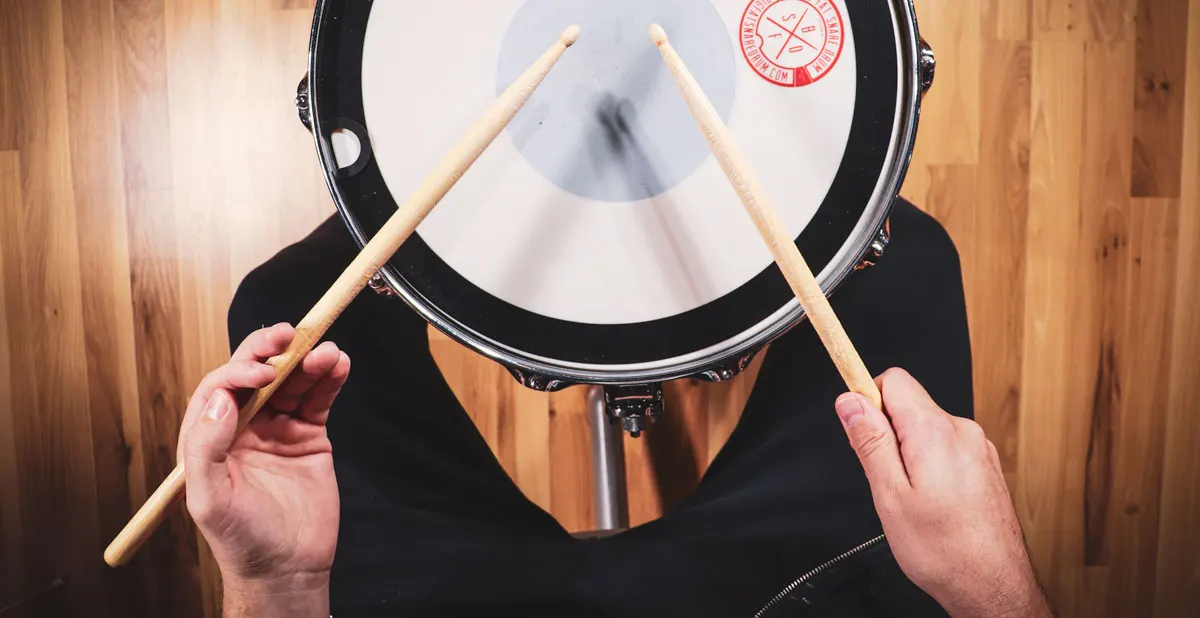Traditional Grip vs. Matched Grip – Which Should You Play?


Look at most modern drummers, and you’ll find them playing with matched grip. But, of course, that doesn’t mean traditional grip doesn’t have its benefits, though unless you are playing marching snare or jazz, it’s hard to justify attaching yourself to that style.
Whether you learned to play drums decades ago or enjoy watching classic videos of drummers from the early 20th century flying around the toms with that unique underhand grip, you’re probably wondering,
What happened?
Did traditional grip die, and if so, is it because it isn’t the superior grip?
We’re here to answer all your questions and more.
Let’s dive in and learn everything you need to know about traditional grip vs. matched grip.
A Short History of Traditional Grip
At one point, traditional grip was THE way to play drums. This is because the modern drum kit as we know it evolved from the marching snare, and marching drummers had to carry their drums with a sling over their shoulders.
Because marching drums tilt downward, playing with one stick upside down is most effective. As drum kits evolved and drummers started sitting behind their kids, they would angle their snare drums forward, allowing them to utilize their traditional grip.
Of course, this does not mean that matched grip wasn’t around then. On the contrary, people have been playing drums for centuries. Historians believe that some of the first drumsticks were invented in the 1300s, though conflicting information suggests they may have been developed in Asia during the 7th century. This leads us to believe that, statistically, someone was playing with matched grip.
As popular music began to shift from big bang jazz and marching music to funk and rock and roll, so did the way we held our sticks.
Which Grip Is Better?
Now, because it seems like traditional grip is dead in the water for modern musicians, making way for matched grip, there are some pros and cons of each grip style.
Traditional Grip Advantages
Traditional grip is mainly found in jazz, as it is one of the few genres that often require subtle playing. If you’ve ever tried to explore brush techniques in jazz, you’ll know what we’re talking about.
With little effort, you can play multiple strokes and quieter notes with traditional grip. It’s also a much better grip for marching settings, where you are playing on tilted drums.
Of course, there is also the fact that traditional grip pays homage to old drumming legends and looks cool when used in the proper context.
Traditional Grip Disadvantages
With all of that said, traditional grip can take much longer to master, and it makes it more challenging to play on a level drum. The learning curve is very steep compared to matched grip, and executing a flawless technique is tricky.
You can set yourself up for injuries if you use the grip without good technique. Beyond that, moving around the drum kit with traditional grip is a bit harder, and so is playing powerful strokes.
Overall, many think of traditional grip as an antiquated concept, as it likely wouldn’t become relevant if the drum set were invented today.
Matched Grip Advantages
Look at almost any modern drummer, and you’ll find them playing matched grip. However, it has yet to become the bread and butter for modern drummers because people like hopping on the bandwagon. It’s much easier to learn, feels more natural, and, in many ways, is a more practical drumming style.
When you start learning drums, matched grip makes it much easier to control the sticks. Because each hand is holding a stick in a similar position to the other, the dominant hand can teach the weaker hand how to play, so both can reach the same skill level.
Creating consistent and powerful strokes with matched grip is also much easier, and moving around the kit is far more efficient. While this grip may be harder to create subtleties, the sheer power expands your overall dynamic range.
At some point down the line, you may introduce mallets into your playing, and feeling comfortable with matched grip can help.
Matched Grip Disadvantages
In the case of matched grip, it can be more challenging to emulate particular styles, such as jazz. Other than that, we can only think of a few other disadvantages, other than the fact that it may inhibit you from using full strokes if you are playing on the hi-hat cross-handed.
Drummers that Use Traditional Grip
Matched grip has become a one-size-fits-all approach to drumming, as it is more ergonomic and has been refined by drumming teachers worldwide.
So, does that mean traditional grip is a dying art?
While it might not be as common for modern drummers, there are plenty of iconic names still playing underhand:
- Stewart Copeland
- Steve Smith
- Vinnie Colaiuta
- Dave Weckl
- Todd Sucherman
- Cindy Blackman Santana
- Steve Gadd
Even Thomas Lang started out playing traditional grip, even though he eventually had to switch to matched grip due to the risk of injury for his playing style.
Is Traditional Grip Worth Learning?
If you are new to drums and trying to decide which grip to learn, look at classical percussionists. Does a vibraphonist or timpanist use by traditional grip? No.
Even serious percussion students don’t need to learn traditional grip when they can get all the sounds they need from matched grip. The same thing can be said about most modern drummers you likely look up to.
Traditional grip is unique in many ways, as it uses the arm’s natural turning motion from the forearm to the wrist to the hand. For some people, that distinct turning motion can feel very comfortable, especially when playing subtly on the snare.
However, getting comfortable with learning to play drums should start with matched grip, as it’ll open up more opportunities in your career.
Final Thoughts
We hope this article gave you a better insight into the two main drumming grips, so you can more confidently decide which one is right for you.
With everything said, neither of these grips is better than the other. It all comes down to what you feel more comfortable playing with.
If you’re a drummer that enjoys playing multiple genres, you may find yourself switching back and forth between these two grips, which is excellent!
Plenty of rock drummers play with traditional grip, and jazz drummers play with matched grip, so feel free to do something differently if it feels natural.




